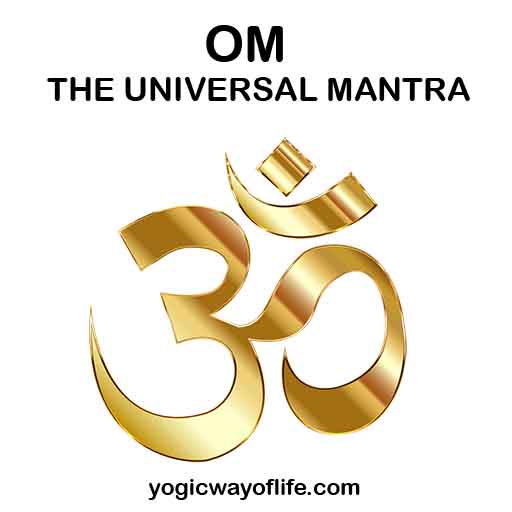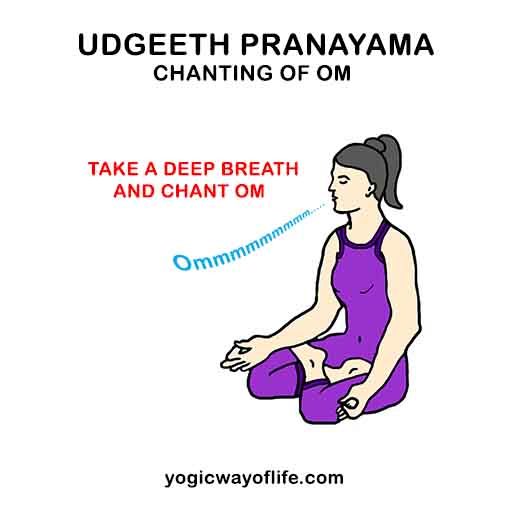OM, also written as AUM is called Pranava Mantra or Omkara. It is the most hallowed syllable and is considered the origin and base of all sounds, as well as the creation. OM is a common symbol, found in the ancient texts of Hinduism.
Besides Pranava, the other terms used for the syllable Om are Akṣhara (imperishable, immutable), Ekākṣara (One lettered mantra). Also, Udgitha, a word found in Sama Veda, is another name of Om or AUM.
OM – The Universal Mantra
Om is the most universal syllable. It neither belongs to particular religion nor does it refer to any God in particular. Syllable Om is considered as the cosmic sound which initiated the creation of universe. The significance of syllable Aum has been explained in many Hindu Scriptures and traditional practices followed in India.
There are numerous meanings and interpretations of the word OM. The most common interpretations of syllable AUM is as follows:
A – Represents Creation
U – Represents Preservation
M – Represents Destruction
And the nasalized consonant in the mantra, which follows, is the silent syllable that signifies “beyond creation.”

What is a Mantra?
A mantra stands for a sacred word, sound or phrase, which has a spiritual and psychological power. “Mananaat Trayathe iti Mantrah” – which means, that which takes you beyond by constant repetition is Mantra. Mantras are referred to as “tools of thought” in Sanskrit. More often than not, a mantra is used in meditation as a tool to control and focus the mind. During meditation a mantra is repetitively chanted to allow the mind to enter into a meditative state. This helps the meditator to connect to the divine within.
Mantras are very powerful tools, which can even change the vibration of the person and the place, thereby evoking a higher level of consciousness in oneself as well as positivity the surroundings.
Why do we call OM the universal mantra?
OM or AUM tri-syllabic, the waveform of Om mantra is made up of 3 phonemes “A-U-M.” These three syllables are basic sounds that a human voice box can create, and all the other sounds can be created with the variation of these three sounds, and that is why AUM is considered the universal sound or the origin of all sounds.
OM in ancient spiritual texts
Some philosophical texts recommend syllable Om as a means for meditation and many affirm that the syllable is the essence of life, Brahman, consciousness, Atman, Self-knowledge, and the ultimate truth.
OM is often chanted either independently or before a mantra. The OM sound or mantra is the primordial sound and hence it is also called the Shabda-Brahman (Brahman or Ultimate reality as sound vibration).
AUM is part of the iconography, which is found in ancient and medieval era manuscripts, temples, monasteries and spiritual retreats in Hinduism, Buddhism, and Jainism. The symbol has a spiritual meaning in all Indian texts. It is considered one of the most spiritual sounds in Hinduism.
It can be seen at the beginning and in the end of chapters in the Vedas, the Upanishads, and other Hindu texts. OM is chanted in almost all the puja’s, prayers, ceremonies such as wedding etc. in Hinduism. In fact, the syllable is used in other religions as well, which includes Buddhism, Jainism and Sikhism.
Origin of OM is in the Vedas
The syllable Om was first mentioned in the Upanishads, the religious texts analogous to the Vedanta philosophy. In the Upanishads, the syllable OM symbolizes abstract spiritual concepts. However, in the Aranyaka and the Brahmana layers of Vedic texts, the syllable stands for the “whole of Veda.” For example, the Aitareya Brahmana of Rig Veda, advocates that the three phonetic components of AUM communicate the three stages of cosmic creation, and whenever it is chanted or simply read, the mantra celebrates the creative powers of the universe.
The Sama Veda, on the other hand, delineate Om to the audible. It aims to extract musical meters from the numerous variations of the syllable such as Oum, Aum, Ovā Ovā Ovā Um, etc.
Representation of OM in Upanishads
In the Upanishads, the syllable “Om” is described as “the sacred sound, the Udgitha (song of the universe), the infinite, the all-encompassing, the whole world, the ultimate reality, the truth, the finest essence, the essence of life, the cause of the Universe, the Brahman, the Atman, the vehicle of deepest knowledge, and Self-knowledge.”
AUM in Chandogya Upanishad
The Chandogya Upanishad, one of the oldest Upanishads of Hinduism, opens with the recommendation that “let a man meditate on Om”. It describes the syllable Om as udgitha and affirms that it is highest song. According to Chandogya Upanishad, it is the symbol of awe, of reverence, of threefold knowledge wherein the Adhvaryu invokes it, the Hotri recites it, and the Udgatri sings it.
AUM in Mundaka Upanishad
In the second part of the Mundaka Upanishad, syllable OM is described as the means to know the self, or self-reflection and introspection.
In his commentary on the Mundaka Upanishad, Adi Shankara stated Om as a symbolism for Atman (soul, self).
AUM in Mandukya Upanishad
The Mandukya Upanishad starts with, “Om!, this syllable is this whole world”. Later, it explains the meaning and the significances of the syllable AUM. And the discussion is built on a structure of “four fourths” or “fourfold”, derived from A + U + M + “silence” (or without an element). The discussion on Om is as follows:
Aum as all states of time
Verse 1 of the Upanishad says that the time is threefold: the past, the present and the future, and these three are “Aum”. Also, the four fourth of time is that which transcends time, that too is “Aum” expressed.
Aum as all states of consciousness
Verses 3 to 6 of the Upanishad specifies four states of consciousness: wakeful, dream, deep sleep and the state of ekatma (being one with Self, the oneness of Self). These four are A + U + M + “without an element” respectively.
Aum as all states of knowledge
Further, verses 9 to 12 of the Mandukya Upanishad explains fourfold etymological roots of the syllable “Aum”. Accordingly, it states that the first element of “Aum” is A, which is from Apti (obtaining, reaching) or from Adimatva (being first). The second element is U, which is from Utkarsa (exaltation) or from Ubhayatva (intermediateness). The third element is M, from Miti (erecting, constructing) or apīti (annihilation). And, the fourth is without an element, without development, beyond the expanse of universe. Hence, the syllable Om is indeed the Atman (the self).
AUM in Maitri Upanishad
The sixth lesson of Maitrayaniya Upanishad discusses the meaning and significance of Om as Brahman-Atman. According to Upanishad, the world is Om, its light is Sun, and the Sun is also the light of the syllable Om. Furthermore, meditating on Om, is acknowledging and meditating on the Brahman-Atman (Soul, Self).
OM in Bhagavad Gita
The significance of syllable Aum is highlighted in various verses of the Bhagavad Gita.
For instance — Krishna to Arjuna, Bhagavad Gita 9.17
पिताहमस्य जगतो माता धाता पितामह: |
वेद्यं पवित्रमोङ्कार ऋक्साम यजुरेव च || 17||
pitaham asya jagatomata dhata pitamahah
vedyam pavitram omkara rk sama yajur eva ca|| 17||
Meaning: I am the Father of this world, Mother, Ordainer, Grandfather, the Thing to be known, the Purifier, the syllable Om, Rik, Saman and also Yajus.
Verse 17.24:
तस्माद् ॐ इत्युदाहृत्य यज्ञदानतप:क्रिया: |
प्रवर्तन्ते विधानोक्ता: सततं ब्रह्मवादिनाम् || 24||
tasmād oṁ ity udāhṛitya yajña-dāna-tapaḥ-kriyāḥ
pravartante vidhānoktāḥ satataṁ brahma-vādinām|| 24||
Meaning: Therefore, when performing acts of sacrifice, offering charity, or undertaking penance, expounders of the Vedas always begin by uttering “Om” according to the prescriptions of Vedic injunctions.
OM in Patanjali Yoga Sutra
Pantanjali’s Yogasutra relates syllable Om to Yoga practice, which is explained in verse 1.27:
तस्य वाचकः प्रणवः ॥२७॥
His word is Om.
Meaning: The verse above underlines the importance of syllable Om in the meditative practice of Yoga, it symbolizes three worlds in the Soul; the three times – past, present and future eternity, the three divine powers – creation, preservation and transformation in one Being; and three essences in one Spirit – immortality, omniscience and joy. Syllable Aum evokes a Bhava of reverence and complete surrender, this is the only path that helps one to connect with a higher reality.
OM in Puranas
Vayu Purana states, Om represents the Trimurti, and their union, viz. A – Brahma, U – Vishnu and M – Shiva. Also, the three sounds symbolise the three Vedas, namely- Rig Veda, Sama Veda, and Yajur Veda.
However, the Shiva Purana specifies the relation between deity Shiva and the syllable Om or Pranava. According to Shiva Purana, “Shiva is Om, and Om is Shiva.”
Syllable OM in other Mantras
Om is a sacred syllable or sound which belongs to none of the religion in particular, however, it is used as a standard expression in the beginning of many mantras, chants or citations taken from the Vedas. Mantras of most deities start with syllable Om.
For instance, the Gayatri mantra, also called Savitar mantra, is the highly revered mantra from the Rigveda Samhita.
ॐ भूर्भुवः स्वः, तत्सवितुर्वरेण्यं
भर्गो देवस्य धीमहि, धियो यो नः प्रचोदयात् ॥
Om Bhuur-Bhuvah Svah, Tat-Savitur-Varennyam
Bhargo Devasya Dhiimahi, Dhiyo Yo Nah Pracodayaat ||
Gayatri mantra, it has Om in the beginning, which simply signifies word of creation, first word, and word of god; and is followed by the formula bhūr bhuvaḥ svaḥ.
There are many such mantras or incantations with syllable OM in the beginning. Few common ones being Om Sri Ganeshaya Namaha, Om Namah Shivaya, Om Namo Bhagavate Vasudevaya, Om Dum Durgaya namaha, Om Hum Hanumate Namaha, etc.
Yogic Practice of Chanting OM
Yogic practice of chanting Om is called Udgeeth Pranayama. This is simple and prolonged chanting of word Aum.

Sit in a cross legged position like Padmasana, Sukhasana, etc. You may even sit on a chair with spine erect. Chant Om in the prolonged way. To learn the correct way of chanting Aum, break down the sound into three parts followed by silence. First chant the sound “A” or “Aaaaaa”, followed by “U” or “Oooooo…” and then “M” as “Mmm….”. This should be followed by a brief silence.
Benefits of Chanting AUM
When we combine all the three basic syllables, AUM mantra is created, which when chanted activates the stomach, spinal cord, throat, nasal and brain regions. The energy starts to move from the abdomen region towards the brain, thereby activating the spinal cord & brain.
Many researches have been done world-wide to understand the effects of Aum mantra on human mind. Which shows; chanting Aum mantra improves our focus and concentration. It gives peace and steadiness to our mind, thereby reducing the mental stress and clearing all the worldly thoughts.
Final Thought
Besides, the significance of syllable Om is described in various other scriptures, religions, and cultures which includes Katha Upanishad, Shvetashvatara Upanishad, Aitareya Aranyaka, Jainism, Buddhism, Sikhism, Japanese, Chinese, Korean, and Tibeten texts.
It is believed that the syllable Om reflects the cosmological faith in Hinduism, as the primordial sound that is associated with the creation of universe from nothing.

Thank you with deep gratitude!
I think it will be much better to add chanting of OM mantra for all backgrounds of your readers.